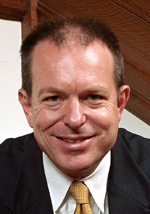Isaac Newton’s “a-ha” moment may have come while he was sitting alone under an apple tree, but that big idea might never had happened if he hadn’t spent so many hours discussing the laws of physics with fellow scientists and philosophers.
 |
|
Keith Sawyer, professor of education and psychology in Arts & Sciences, discusses his latest book, Group Genius, due out in June.
|
In his latest book, Keith Sawyer, Ph.D., one of the country’s leading scientific experts on creativity, argues that collaboration is essential in helping all of us harness the power of our own creative genius.
“Group Genius: The Creative Power of Collaboration” is the most recent work from Sawyer, an associate professor of education and of psychology, both in Arts & Sciences at Washington University in St. Louis.
“I wrote ‘Group Genius’ because there is a lot of exciting research coming out of the laboratories about creativity and innovation that hasn’t yet made it to the general public,” says Sawyer. “This research is focused on being more creative in your personal life and also on how to make organizations more innovative, something businesses today are very interested in.”
Sawyer, who routinely speaks to business leaders throughout the country on creativity and innovation, says the book is aimed not only at business managers, but “just about everyone who is interested in being more creative in all facets of their life.”
He explains that “Group Genius” features two main messages. “First is that the psychology of creativity shows creativity to be based in everyday brain processes that all of use all the time. Everybody has the potential for exceptional creativity. It’s not the case that creative people are unique geniuses who are different from everyone else.”
The second message is the power of collaboration in becoming more creative. “That’s why I decided to call it ‘Group Genius,'” says Sawyer, who is also author of “Explaining Creativity: The Science of Human Innovation.”
“In my research, I’ve found that people are always more creative in a collaborative group of a certain kind,” he explains. “They are more creative when they work in organizations that bring everyone’s creativity together.”
Finding unique combinations
According to Sawyer, there are two fairly simple ways all of us can go about becoming more creative people.

One of those is to look inside ourselves and try to tap into those everyday brain processes. A common way to do this is through the use of “combination,” Sawyer says.
“Combination is when you put together two concepts in your mind that have previously been separated, resulting in a significant innovation,” he says. “That could be something simple like Reese’s Peanut Butter Cups — combining peanut butter and chocolate. That might be an easy combination, but you can look for combinations that aren’t so obvious.”
Research shows that if you take two concepts that are more distant from each other and combine them you are more likely to get a significant innovation.
An example of this, says Sawyer, is combining a potato chip and a magazine. “At first you think, ‘A potato chip and a magazine? That doesn’t make any sense.’ But if you think about it, you could come up with Pringles Prints potato chips — as Procter & Gamble did — which is a Pringle with words printed on it with edible vegetable dye. It’s not really a magazine, but it is text and you end up with that unexpected combination that people aren’t anticipating.”
Another way to hone creativity is to tap into the people around you and the power of collaboration.
“In my research I find over and over that the most critical and significant innovations are the result of working together,” says Sawyer, who has completed extensive studies on improvisation in Chicago improvisational theatre and jazz music groups.
“Most people find that they are more creative when they are working with a creative group of people. It’s a myth that people are creative when they go off alone into the woods or study in an attic somewhere. That’s not the way creativity works. Creativity is always embedded in collaborative groups.”
Historic examples of creative innovation
“Group Genius” makes the latest research on improvisation and creativity easily accessible. In much of the book, Sawyer tells stories about the history of creative innovation, including the mountain bike, the light bulb and famous novels such as “Lord of the Rings.”

The examples in the book range from the historical, like the invention of the telegraph, to modern-day innovations such as the ATM, the Internet and computer mouse.
“One of the myths we believe about these innovations are that they were invented by one key genius inventor,” Sawyer says. “Underneath the surface of that myth, it turns out always to be false.
“It’s not really the case that Samuel Morse invented the telegraph,” Sawyer continues. “There were scores of people who contributed and played a role in the sequence of ideas and insights that had to happen before the telegraph could become a reality.”
Sawyer contends that everyone is creative.
“My research, and the research of my colleagues, indicates that creativity is not found in a separate brain region. It’s not a personality trait, like IQ. It’s really based in everyday brain processes that we use in everyday tasks, like driving around a traffic jam or making a recipe you’ve never made before. We already have the building blocks we need. To become more creative, it’s just a matter of learning how to put them together in a new and different way.”
Professor Sawyer is available for live or taped interviews using Washington University’s free VYVX or ISDN lines.